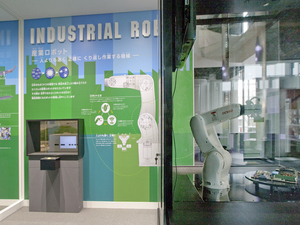Nagoya City Science Museum
TOP > Exhibition Guide > Keyword Search > Starting with "I" > image processing > Industrial Robot
Industrial Robot



Purpose of Exhibition
After manufacture of a product has been completed in a factory, product testing must be done. In some cases, all the products are the objects, and in other cases only some randomly selected products are the objects. People check for any abnormalities in the products... However, it is difficult to inspect many products in a limited time.
As a result, more effective approaches have been determined. There are many items in the product inspection. The appearance check is important, too. Whether the parts are installed correctly, whether the screws are firmly attached, these kind of details can be confirmed visually, and in recent years they have been performed by robots.
The purpose of the exhibition is to help you realize how quick and accurate testing by robots can be.
Additional Knowledge
<What are robots?>
When ordered, can we really call a mechanical device which conducts pre-determined movements a robot?For example, vending machines are devices which substitute to perform tasks, but it is determined by people whether these are viewed as robots.
There is no clear definition of robots.
However, we can think about robots in the following definitions:(1) An automatic Device which conducts self-continuous tasks to a certain extent. (2) A device with forms and functions similar to people, like the robots that have appeared in SF works ay, the origin of 'the robot' is as follows:A Czech novelist, Karel _apek, created it and utilized it in his drama "R.U.R", publicized in 1921. It has since spread and it is widely used in general. Its origin was supposed to mean "labor", robota in the Czech language.
<Industrial robots>
In Japan about 100000 industrial robots are manufactured annually, and this accounts for 70% of the industrial robots produced throughout the world. Japan is the world's most industrial robot-producing country. Superiority of industrial robots in Japan is supported by its cultural background. In European countries and the USA, there is a belief that humans have been created in the image of god, and therefore there is a resistance to create things like human (robots).
Not only that, it seems that robots deprive humans of employment.
Today, it is said that about 800000 industrial robots function throughout the world, and 35000 robots which account for about 40% have been used in Japan, these robots provide a big contribution to high _volume manufacturing in Japan.
For example, in automobile factories, the cars are assembled, welded, painted, and robots can play a vital role in these processes.
In electrical equipment companies, much of the product assembly is performed by an articulated robot with arms shaped like human hands.
<Structure of Articulated Robots>
An articulated Robot is composed of the following 3 devices: a sensor, a controller and an arm. A sensor catches the latest robot's action and surroundings. A controller determines the action based on the information from the sensor. An arm works by receiving the command from the controller.
A sensor has functions which are equivalent to human senses, such as recognizing the positioning and speed of the arms.
These inspection robots have CDD cameras which play the role of human eyes. The controller, which receives the information captured by the sensors can pre-fill work as directed and move the robot arm. The controller is the brain of the robot.
By moving the wheels by force of motors which control the speed, they move the arms properly.
<Teaching>
The robots must be taught in advance what tasks they are supposed to perform.
As for this inspection robot, it must be taught on which part to move the camera and in what position. This work is called 'teaching'.
More concretely, the task of the robot is to remember the positions of the beginning and end points.
<Feedback Control>
Simultaneous actions of many motions motors in the robot lead to the robot's quick motion. This inspection robot checks as much as 1000 times per second and it is reflected in the movement of the robot. Such a task is called feedback control. This technology is behind the quick, accurate and smooth movements of the robot.
<Image Processing>
Of particular importance in this inspection robot is image processing. The images taken by an inspection robot equipped with a CDD camera are sent to image processing devices in the controller. In short, those should be compared with images of pre-filled state, and output any difference. The robot is equipped with a program informing in case of abnormality.
.
Cooperation: DENSO CORPORATIONArticle by Koichi Mabuchi, curator
